Balkans correspondent
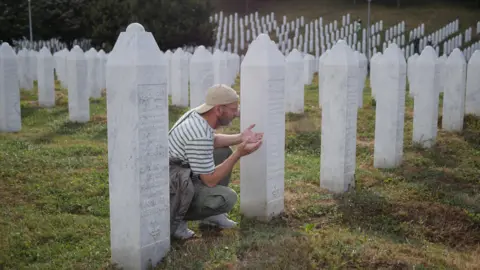 BBC
BBCThe silence is shattered by a guttural scream. A group of people scrabble on the ground, sifting through the soil. One of them holds up a watch they have uncovered; another, a sandal.
The scene on stage at Sarajevo’s War Theatre is uncomfortably familiar for the audience at the world premiere of the Flowers of Srebrenica. The play reflects the grim reality of the events not just of July 1995 – but the ensuing decades of unresolved grief and divisions in Bosnia and Herzegovina.
The Srebrenica massacre remains the most notorious war crime committed in Europe since World War Two. Bosnian-Serb forces overran Srebrenica in eastern Bosnia, where thousands of Bosniaks, who are mostly Muslim, had taken refuge, believing they were safely under the protection of the United Nations.
Instead, Dutch soldiers stood aside as Bosnian-Serb General Ratko Mladić directed his troops to place women and the youngest children on buses for transport to majority-Bosniak areas. Then, over the following days, he oversaw the systematic murder of around 8,000 people – most, but not all of them, men and boys.
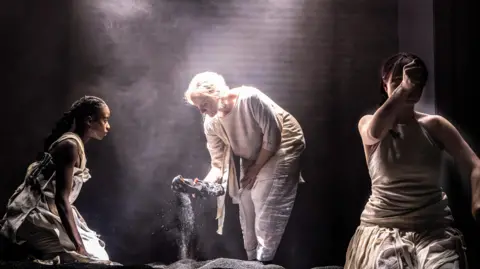 Sarajevo’s War Theatre
Sarajevo’s War TheatreMladić’s troops dumped the bodies in mass graves. But later, to cover up their crimes, they exhumed then reburied the remains in multiple sites.
As a result, body parts were distributed across multiple graves, causing endless anguish for the victims’ families. Many of them are still searching for their relatives’ remains decades later, though DNA testing has helped thousands of families to bury their family members at Potočari Cemetery, adjacent to the former UN base.
Others have been able to identify body parts through scraps of clothing or personal belongings – as depicted in scenes in the Flowers of Srebrenica.
The play also reflects the apparently deepening divisions in contemporary Bosnia and Herzegovina. While the audience in Sarajevo delivers a standing ovation to the cast and crew, in majority-Serb Republika Srpska, political leaders repeatedly deny that genocide took place at Srebrenica, despite Mladić’s conviction for the offence at an international tribunal in The Hague, as well as the earlier conviction of the Bosnian-Serb political leader Radovan Karadžić.
“I thought that when 30 years passed, we’d come to our senses,” says Selma Alispahić, the lead actress of the Sarajevo War Theatre – herself a former refugee from Bosnia’s conflict.
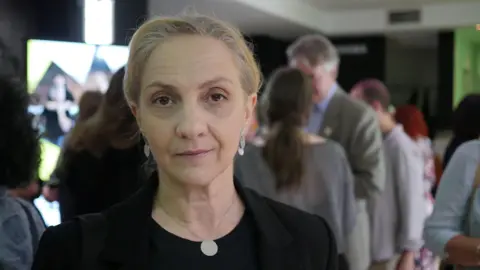
“People get tired of proving the truth that’s been proven so many times, even in international courts. The story of the hatred and spinning of facts serves only the criminals who profited from the war and who want to preserve their fortune today.”
Genocide denial is not the only symptom of the country’s divisions. The Dayton Peace agreement brought an end to the war, just four months after the massacre. But it also divided Bosnia and Herzegovina into two “entities”, on ethnic grounds. Most Bosniaks and Croats live in the Federation, while the majority of Serbs are in Republika Srpska.
There is also a state-level government, with a member of the presidency for each of the three main ethnic groups. But most of the power lies at the entity level.
In recent months, Republika Srpska’s president has been exploiting that to make mischief. Milorad Dodik has been pushing through legislation to withdraw from numerous national institutions, including the judiciary. This has brought him into conflict with Bosnia’s ultimate power, the international High Representative.
The current holder of that position, Christian Schmidt, annulled the laws concerned. But Dodik refused to recognise those rulings.
Earlier this year a court sentenced him to a year in prison and a six-year ban from public office for ignoring the High Representative’s decisions. The verdict is currently under appeal.
Further shenanigans have ensued – including legislation to establish a “reserve police force”. The same terminology was used for murderous Serb militia during Bosnia’s conflict.
“This is dangerous, playing with the memory of those who have experienced the 1990s,” says Mr Schmidt.
“I see the irresponsible part of the political class playing with this. We need a clear presence of the international community on a military level – so EUFOR [the EU peacekeeping force] gets more responsibility in the sheer presence, promising people they will be supported in a peaceful manner.”
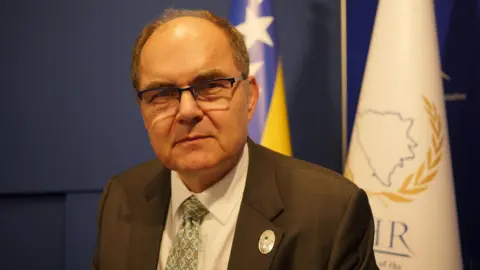
In the centre of Sarajevo, reminders of the anniversary of the Srebrenica massacre are hard to miss. Hundreds of people huddled under umbrellas in the pouring rain to pay their respects to the convoy carrying the remains of seven recently-identified victims who will be buried at Potočari Cemetery during the commemoration. Outside the city’s shopping centres, video screens urge passers-by to “Remember Srebrenica”.
But just 15 minutes up the road, in East Sarajevo, there are no public references to the massacre. The Cyrillic script signs and Jelen Beer umbrellas indicate that this is Republika Srpska. And in the entity government’s building, there is little enthusiasm for the commemorations.
Indeed, state-level foreign trade minister Saša Košarac – a leading member of Dodik’s SNSD party – claims that Srebrenica is used to deepen divisions and prevent reconciliation.
“In this country, Bosniaks, Croats and Serbs were killed – and crimes were committed on all three sides. It’s important, when thinking about the future, that all the perpetrators, on all sides, should be held accountable,” he says.
“Bosniaks insist on talking only about Bosniak victims. A crime has been committed in Srebrenica – no Serbs deny that – but we have the right to point out the crimes against Serbs in and around Srebrenica.”
But thousands of other people are focusing on solidarity with Srebrenica. On the eve of the commemoration, the Memorial Centre and Potočari Cemetery were already busy with people paying their respects. And they cheered the arrival from around the country of groups of cyclists, runners and motorcyclists.
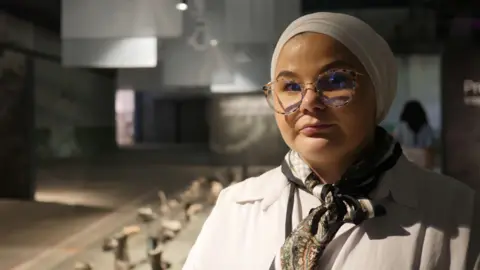
Mirela Osmanović says this support is crucial to Bosniaks who have returned to live in the area where their family members died. She was born two years after her two brothers were murdered at Srebrenica and now works at the Memorial Centre. But the recent tensions have left her rattled.
“The intense atmosphere produced by Republika Srpska’s leaders really disturbs us, making us feel we’re not protected anymore – and we’re really worried about our future.”
“My parents say it looks the way it looked in 1992.”
For Milorad Dodik, manipulating the cycle of tensions is just part of his strategy to remain in power. But for people in Srebrenica, the ongoing ethno-political games only make the healing harder.
